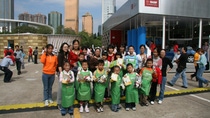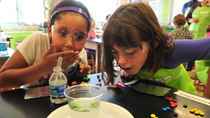Experiments for clever foodies - Water or oil?
In June 1997, BASF launched Kids’ Lab, the first hands-on chemistry workshop in Europe at its headquarters in Ludwigshafen. It is an interactive, fun and free chemistry education program designed for kids ages six to 12 to discover the world of chemistry through simple and safe experiments.
In 2002, to commemorate the 30th anniversary of the establishment of diplomatic relations between China and Germany, BASF Kids’ Lab made its debut in Beijing. Ever since, the program has been brought to cities including Shanghai, Nanjing, Chongqing, Guangzhou, Shenyang, Wuhan, Hong Kong, Taipei, Kaohsiung and Taoyuan. It has now reached more than 170,000 children in China. All along, “BASF Kids’ Lab” is welcomed by children and parents and has become a must-go event each summer.
In 2017, BASF celebrates the 20th anniversary of Kids’ Lab, and marks 15 years of Kids’ Lab in China. On this occasion, a series of home experiments are hosted to create a high-quality parenting and interaction atmosphere and stimulate the curiosity and exploration of kids.



